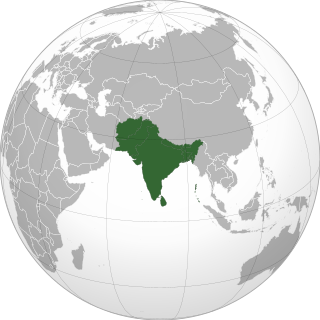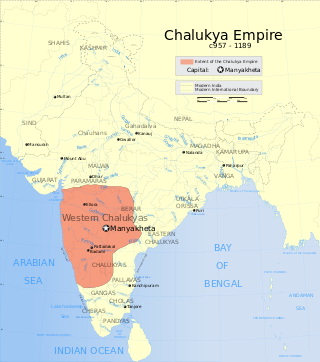Related Research Articles

The middle kingdoms of India were the political entities in the Indian subcontinent from 230 BCE to 1206 CE. The period begins after the decline of the Maurya Empire and the corresponding rise of the Satavahana dynasty, starting with Simuka, from 230 BCE. The "middle" period lasted for almost 1436 years and ended in 1206 CE, with the rise of the Delhi Sultanate, founded in 1206, and the end of the Later Cholas.

The Pratihara dynasty, also called the Gurjara-Pratiharas, the Pratiharas of Kannauj or the Imperial Pratiharas, was a prominent medieval Indian dynasty which ruled over the Kingdom of Kannauj. It initially ruled the Gurjaradesa until its victory in the Tripartite Struggle in 816 which secured its right to the throne of Kannauj. Cadet branches of the dynasty ruled other minor states in the subcontinent.

Amoghavarsha I was the greatest emperor of the Rashtrakuta dynasty. His reign of 64 years is one of the longest precisely dated monarchical reigns on record. Many Kannada and Sanskrit scholars prospered during his rule, including the great Indian mathematician Mahaviracharya who wrote Ganita-sara-samgraha, Jinasena, Virasena, Shakatayan and Sri Vijaya.

The Rashtrakutas were a royal Indian dynasty ruling large parts of the Indian subcontinent between the 6th and 10th centuries. The earliest known Rashtrakuta inscription is a 7th-century copper plate grant detailing their rule from Manapur, a city in Central or West India. Other ruling Rashtrakuta clans from the same period mentioned in inscriptions were the kings of Achalapur and the rulers of Kannauj. Several controversies exist regarding the origin of these early Rashtrakutas, their native homeland and their language.

Govinda III was greatest Rashtrakuta monarch who succeeded his illustrious father Dhruva Dharavarsha. He was militarily the most successful emperor of the dynasty with successful conquests from Kanyakumari in the south to Kanyakubja in the north, from Banaras in the east to Bharuch in the west. From the Someshvara inscription of 804, it is known that 'Gamundabbe' was his chief queen.

Tailapa II also known as Taila II and by his title Ahavamalla, was the founder of the Western Chalukya Empire in peninsular India. Tailapa claimed descent from the earlier imperial Chalukyas of Vatapi (Badami), and initially ruled as a Rashtrakuta vassal from the Tardavadi-1000 province in the present-day Vijayapura district of Karnataka. When the Rashtrakuta power declined following an invasion by the Paramara king Siyaka, Tailapa overthrew the Rashtrakuta emperor Karka II, and established a new dynasty.

The Western Chalukya Empire ruled most of the western Deccan, South India, between the 10th and 12th centuries. This Kannada-speaking dynasty is sometimes called the Kalyani Chalukya after its regal capital at Kalyani, today's Basavakalyan in the modern Bidar district of Karnataka state, and alternatively the Later Chalukya from its theoretical relationship to the 6th-century Chalukya dynasty of Badami. The dynasty is called Western Chalukyas to differentiate from the contemporaneous Eastern Chalukyas of Vengi, a separate dynasty. Before the rise of these Chalukyas, the Rashtrakuta Empire of Manyakheta controlled most of the Deccan Plateau and Central India for over two centuries. In 973, seeing confusion in the Rashtrakuta empire after a successful invasion of their capital by the ruler of the Paramara dynasty of Malwa, Tailapa II, a feudatory of the Rashtrakuta dynasty ruling from Bijapur region defeated his overlords and made Manyakheta his capital. The dynasty quickly rose to power and grew into an empire under Someshvara I who moved the capital to Kalyani.
Krishna II ascended the Rashtrakuta throne after the demise of his illustrious father Amoghavarsha I Nrupatunga. His Kannada name was Kannara. His queen was a Haihaya princess of Chedi called Mahadevi. From the chronology of inscriptions that mention the name of this emperor, it seems Krishna II may have started to rule even during the lifetime of his father. The fact that Amoghavarsha in his last years renounced the affairs of the state in dharmic pursuits supports this claim. The reign of emperor Krishna II saw significant advances in literature, although in the affairs of expansion of the empire, his reign was mixed. During his reign he cultivated matrimonial alliance with Chedis to form military gain.
Govinda IV was the younger brother of Amoghavarsha II. He became the Rashtrakuta emperor in 930 as described in the Kalasa record of Chikmagalur. He was a very unpopular ruler who indulged in licentious acts. Control over Kannauj was lost during his rule. The Chalukyas of Vengi defeated him and much territory was lost. Finally, his own vassals including King Arikesari of Vemulavada revolted against him and placed Amoghavarsha III on the throne in 935. This is known from the records of Kannada poet Adikavi Pampa, who was patronised by King Arikesari. Govinda IV patronised Kannada poet Ravinagabhatta.

Krishna III, whose Kannada name was Kannara, was the last great warrior and able Rashtrakuta Emperor. He was a shrewd administrator and skillful military campaigner. He waged many wars to restore the glory of the Rashtrakutas and played an important role in rebuilding the Rashtrakuta empire. He patronised the famous Kannada poets Sri Ponna, who wrote Shanti Purana, Gajankusha, also known as Narayana, who wrote on erotics, and the Apabhramsha poet Pushpadanta who wrote Mahapurana and other works. His queen was a Chedi princess and his daughter Bijjabbe was married to a Western Ganga prince. During his rule he held titles such as Akalavarsha, Maharajadhiraja, Parameshvara, Paramamaheshvara, Shri Prithvivallabha etc. At his peak, he reigned over a vast empire stretching from at least the Narmada river in the north to at least the Kaveri river delta in the south. A copper grant of 993 issued by the Shilahara king of Thana states that the Rashtrakuta control extended from the Himalayas in the north to Ceylon in the south and from the eastern sea to the western seas. This grant also states that when the emperor Krishna III mobilised his armies, the kings of Chola, Bengal, Kannauj, Andhra and Pandya regions used to quiver.

Pampa, also referred to by the honorific Ādikavi, was a Kannada-language Jain poet whose works reflected his philosophical beliefs. He was a court poet of Vemulavada Chalukya king Arikesari II, who was a feudatory of the Rashtrakuta Emperor Krishna III. Pampa is best known for his epics Vikramārjuna Vijaya or Pampa Bharata, and the Ādi purāṇa, both written in the champu style around c. 939. These works served as the model for all future champu works in Kannada.

Rashtrakuta literature is the body of work created during the rule of the Rastrakutas of Manyakheta, a dynasty that ruled the southern and central parts of the Deccan, India between the 8th and 10th centuries. The period of their rule was an important time in the history of South Indian literature in general and Kannada literature in particular. This era was practically the end of classical Prakrit and Sanskrit writings when a whole wealth of topics were available to be written in Kannada. Some of Kannada's most famous poets graced the courts of the Rashtrakuta kings. Court poets and royalty created eminent works in Kannada and Sanskrit, that spanned such literary forms as prose, poetry, rhetoric, epics and grammar. Famous scholars even wrote on secular subjects such as mathematics. Rashtrakuta inscriptions were also written in expressive and poetic Kannada and Sanskrit, rather than plain documentary prose.
The political history of medieval Karnataka spans the 4th to the 16th centuries in Karnataka region of India. The medieval era spans several periods of time from the earliest native kingdoms and imperialism; the successful domination of the Gangetic plains in northern India and rivalry with the empires of Tamilakam over the Vengi region; and the domination of the southern Deccan and consolidation against Muslim invasion. The origins of the rise of the Karnataka region as an independent power date back to the fourth-century birth of the Kadamba Dynasty of Banavasi which was the earliest of the native rulers to conduct administration in the native language of Kannada in addition to the official Sanskrit.

The Tripartite Struggle (785–816) were a series of wars in northern India fought over the control of the throne of Kannauj, which during that time was equivalent to having imperial status over all of Aryavarta. It involved the three powerful dynasties of the era – the Pratiharas of Gurjaradesa, the Palas of Gauda (Bengal) and the Rashtrakutas of Manyakheta. The war ultimately resulted in Nagabhata II, King of the Gurjaras, winning the crown of Kannauj in 816, and proclaiming himself King of Kannauj.

The Chaulukya dynasty, also Solanki dynasty, was a dynasty that ruled the Kingdom of Gujarat in western India, between c. 940 CE and c. 1244 CE. Their capital was located at Anahilavada. At times, their rule extended to the Malwa region in present-day Madhya Pradesh. The family is also known as the "Solanki dynasty" in the vernacular literature. They belonged to the Solanki clan of Rajputs.

The Kalachuris of Tripuri, also known the Kalachuris of Chedi, ruled parts of central India during 7th to 13th centuries. They are also known as the Later Kalachuris to distinguish them from their earlier namesakes, especially the Kalachuris of Mahishmati. Their core territory included the historical Chedi region, and their capital was located at Tripuri.
The origin of the Gurjara-Pratihara dynasty of India is a topic of debate among historians. The rulers of this dynasty used the self-designation "Pratihara" for their clan, but have been described as "Gurjara" by their neighbouring kingdoms. Only one particular inscription of a feudatory ruler named Mathanadeva mentions him as a "Gurjara-Pratihara".
The Chalukyas of Vemulavada were an Indian dynasty that ruled in and around the present-day Telangana between 7th and 10th centuries. Their capital was located at Vemulavada, and they were vassals of the Rashtrakutas.
Narasimha II was a ruler of the Vemulavada Chalukya dynasty of present-day Telangana, India. As a vassal of the Rashtrakuta king Indra III, he led an Rashtrakuta army against the Gurjara-Pratihara king Mahipala. According to his dynasty's records, he advanced as far as river Ganga, forcing Mahipala to flee.
Arikesari II was a ruler of the Vemulavada Chalukya dynasty of present-day Telangana, India. A Rashtrakuta vassal, he played an important role in dethroning the Rashtrakuta emperor Govinda IV and enthroning Amoghavarsha III as the new emperor. He was the patron of Pampa, one of the earliest notable Kannada-language poets.
References
- Sastri, Nilakanta K.A. (2002) [1955]. A history of South India from prehistoric times to the fall of Vijayanagar. New Delhi: Indian Branch, Oxford University Press. ISBN 0-19-560686-8.
- Kamath, Suryanath U. (2001) [1980]. A concise history of Karnataka : from pre-historic times to the present. Bangalore: Jupiter books. LCCN 80905179. OCLC 7796041.
- Reu, Pandit Bisheshwar Nath (1997) [1933]. History of The Rashtrakutas (Rathodas). Jaipur: Publication scheme. ISBN 81-86782-12-5.